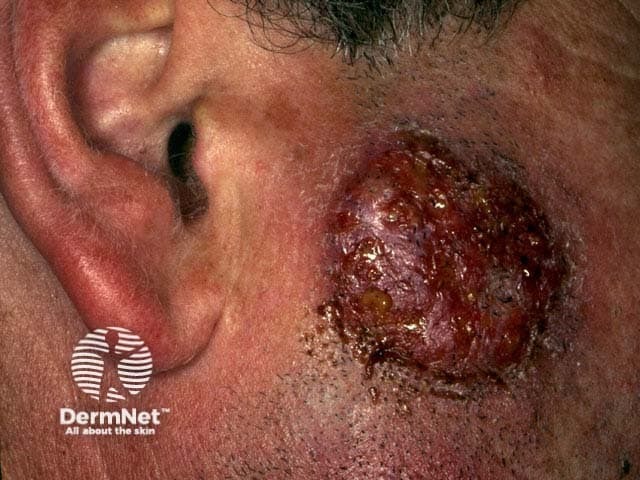Main menu
Common skin conditions

NEWS
Join DermNet PRO
Read more
Quick links
This quiz will test how good you are at diagnosing skin conditions due to fungi, bacteria and viruses.
For each of the ten cases, study the image(s) and then answer the questions. You can click on the image to view a larger version if required.
Each case should take approximately 2 minutes to complete. There is a list of suggested further reading material at the end of the quiz.
When you finish the quiz, you can download a certificate.

What is the diagnosis?
A kerion due to dermatophyte fungus (tinea faciei).
How can the diagnosis be confirmed?
Tinea infections should be always confirmed by mycology. This may be difficult if there is a kerion because the inflammatory response may eliminate most of the fungal elements from view.
Scrapings should be taken from the leading edge of the lesion. Several loose hairs were pulled out, and placed in a Petri dish. The purulent material was swabbed and smeared onto a glass slide. The specimens were sent to the laboratory for potassium hydroxide microscopy and fungal culture. As initial microscopy was negative, the farmer underwent an incisional biopsy for histology. This was reported to be non-specific, showing a vigorous deep mixed inflammatory infiltrate with destruction of hair follicles.
One month later, the laboratory cultured Trichophyton verrucosum.
As the differential diagnosis included infection with Staphylococcus aureus, blue-top swabs were also taken for microscopy and bacterial culture. These were negative.
What treatment should be recommended?
Topical antifungal agents are not usually adequate for kerion. The available systemic antifungal agents are terbinafine, itraconazole, ketoconazole and fluconazole. Griseofulvin is no longer distributed in New Zealand.
T. verrucosum is the cause of cattle ringworm. The farmer had noted areas of hair loss typical of ringworm on several young calves. The animals were not specifically treated. His infection was treated by oral terbinafine 250mg daily for one month. He also received a ten-day course of oral prednisone 20mg daily to rapidly reduce the excessive inflammatory reaction. He was left with a pale hairless area for some weeks but eventually normal appearance was restored.